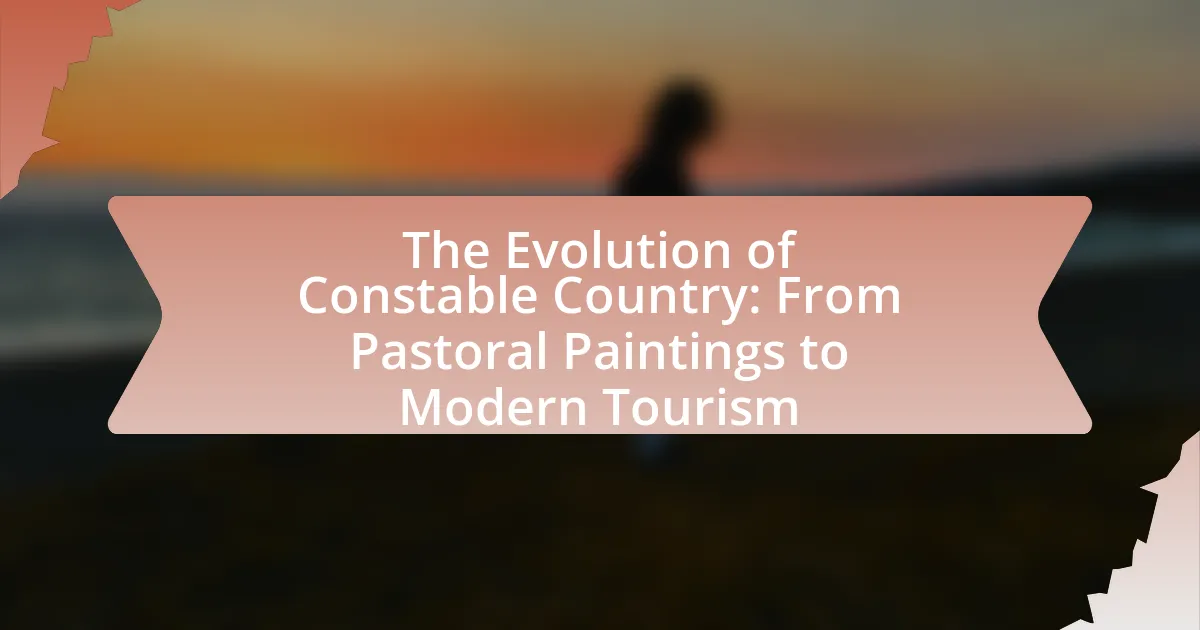Constable Country, located in the Dedham Vale area of Essex, England, is renowned for its picturesque landscapes that inspired the early 19th-century artist John Constable. This article explores the historical significance of Constable Country, detailing how Constable’s iconic paintings elevated the status of English landscape art and influenced perceptions of the countryside. It examines the region’s key features, the transition from art to tourism, and the modern attractions available to visitors, highlighting the ongoing cultural and economic impact of Constable’s legacy on the area. Additionally, the article discusses the role of local events and experiences that celebrate the heritage of Constable Country, providing insights into how visitors can best engage with this historically rich landscape today.

What is Constable Country and its Historical Significance?
Constable Country refers to the picturesque landscape in the Dedham Vale area of Essex, England, famously depicted in the paintings of artist John Constable during the early 19th century. This region holds historical significance as it inspired Constable’s works, which captured the beauty of rural life and contributed to the Romantic movement in art. His paintings, such as “The Hay Wain” and “Dedham Vale,” not only elevated the status of English landscape painting but also influenced perceptions of the English countryside, leading to a greater appreciation for natural beauty and rural heritage. The area’s designation as an Area of Outstanding Natural Beauty in 1970 further underscores its cultural and historical importance, preserving the landscape that inspired Constable’s iconic art.
How did Constable Country get its name?
Constable Country got its name from the renowned English painter John Constable, who depicted the landscapes of the area in his artwork during the early 19th century. His paintings, particularly those showcasing the Suffolk countryside, captured the beauty and essence of the region, leading to its association with his name. The term “Constable Country” reflects the cultural significance of his work, which has contributed to the area’s identity and tourism appeal.
What role did John Constable play in the recognition of this region?
John Constable significantly contributed to the recognition of the region known as Constable Country through his iconic landscape paintings that depicted its natural beauty. His works, such as “The Hay Wain” and “Dedham Vale,” not only showcased the picturesque scenery of the Suffolk countryside but also elevated its status in the art world during the 19th century. These paintings captured the essence of rural life and the charm of the English landscape, leading to increased interest and tourism in the area. Constable’s emphasis on the local environment and his ability to convey its emotional resonance helped establish the region as a cultural and artistic landmark, influencing both contemporary and future perceptions of the countryside.
How did pastoral paintings influence perceptions of Constable Country?
Pastoral paintings significantly shaped perceptions of Constable Country by idealizing its rural landscapes and evoking a sense of nostalgia for the English countryside. These artworks, particularly those by John Constable himself, portrayed the region’s natural beauty, agricultural life, and serene atmosphere, which contributed to a romanticized view of rural existence. The vivid depictions of fields, rivers, and skies in Constable’s paintings, such as “The Hay Wain,” not only highlighted the aesthetic appeal of the area but also influenced public sentiment, leading to increased appreciation and tourism in the region. This artistic representation established Constable Country as a symbol of pastoral tranquility, reinforcing its identity as a quintessential English landscape.
What are the key features of Constable Country?
Constable Country is characterized by its picturesque landscapes, historical significance, and artistic heritage. The area, located in the Dedham Vale in Suffolk, England, features rolling hills, lush meadows, and the River Stour, which inspired the renowned painter John Constable in the 19th century. The region is also home to several historic villages, such as Flatford and East Bergholt, where Constable lived and worked, further enhancing its cultural importance. Additionally, Constable Country is recognized for its biodiversity, with various flora and fauna, making it a popular destination for nature enthusiasts and tourists.
What landscapes and natural elements define Constable Country?
Constable Country is defined by its rolling hills, lush meadows, and tranquil rivers, particularly the River Stour. These landscapes are characterized by picturesque scenes of rural England, featuring elements such as ancient trees, grazing livestock, and traditional farmhouses. The area is renowned for its natural beauty, which inspired the artist John Constable in the early 19th century, leading to the creation of iconic paintings that capture the essence of the English countryside. The specific features of Constable Country, including the flat meadows and the distinctive clouds, are integral to its identity and have been preserved as part of the Dedham Vale Area of Outstanding Natural Beauty, recognized for its scenic value and cultural significance.
How do these features contribute to its artistic representation?
The features of Constable Country, such as its lush landscapes, vibrant colors, and atmospheric effects, significantly enhance its artistic representation by capturing the essence of rural life and nature. These elements evoke emotional responses and create a sense of place that resonates with viewers. For instance, John Constable’s use of light and shadow in his pastoral paintings not only highlights the beauty of the English countryside but also reflects the changing moods of nature, which is a hallmark of Romantic art. This technique invites viewers to engage with the artwork on a deeper level, fostering a connection to the depicted environment. Additionally, the historical context of Constable’s work, rooted in the early 19th century, showcases the transition from agrarian society to industrialization, further enriching the narrative conveyed through his art.
Why is Constable Country important in the context of English art history?
Constable Country is important in the context of English art history because it represents the quintessential landscape that inspired the works of John Constable, a pivotal figure in the Romantic movement. Constable’s paintings, such as “The Hay Wain” and “Dedham Vale,” capture the natural beauty and rural life of this region, emphasizing emotional resonance and a deep connection to the English countryside. His innovative techniques, including the use of light and color, influenced subsequent generations of artists and helped establish landscape painting as a significant genre in English art. The area itself, now a designated Area of Outstanding Natural Beauty, continues to attract visitors and artists, underscoring its lasting impact on both art and cultural heritage.
What impact did Constable’s work have on future artists?
Constable’s work significantly influenced future artists by pioneering the use of natural light and atmospheric effects in landscape painting. His innovative techniques, particularly in capturing the nuances of rural life and the English countryside, inspired the Impressionists and later movements, emphasizing the importance of personal expression and the emotional resonance of landscapes. For instance, artists like Claude Monet acknowledged Constable’s impact on their approach to color and light, demonstrating how his methods laid the groundwork for modern landscape painting.
How does Constable Country reflect the broader trends in 19th-century art?
Constable Country reflects the broader trends in 19th-century art by embodying the Romantic movement’s emphasis on nature, emotion, and individual experience. John Constable’s works, particularly his landscapes, showcase a deep appreciation for the English countryside, which aligns with the Romantic ideal of finding beauty and inspiration in nature. His use of light, color, and texture in paintings like “The Hay Wain” illustrates a shift away from the neoclassical focus on idealized forms towards a more personal and emotive representation of the natural world. This approach not only highlights the changing perceptions of landscape painting during the 19th century but also mirrors the growing interest in rural life and the sublime, which were central themes in Romantic art.
How has Constable Country transitioned from art to tourism?
Constable Country has transitioned from art to tourism by leveraging the legacy of artist John Constable, whose paintings celebrated the natural beauty of the Suffolk landscape. This transition began in the late 20th century as local authorities and tourism boards recognized the potential to attract visitors to the area by promoting its artistic heritage. The establishment of the Constable Country brand, along with the development of walking trails, visitor centers, and art exhibitions, has further enhanced its appeal as a tourist destination. Evidence of this shift is seen in the increase in visitor numbers, with reports indicating that tourism in the region has significantly boosted the local economy, showcasing the successful integration of art into the tourism sector.
What factors contributed to the rise of tourism in Constable Country?
The rise of tourism in Constable Country was primarily driven by its picturesque landscapes and cultural heritage, which were popularized by the works of artist John Constable. The natural beauty of the area, characterized by rolling hills, rivers, and historic villages, attracted visitors seeking scenic views and artistic inspiration. Additionally, the establishment of walking trails and improved transportation links facilitated access to the region, further boosting tourism. The promotion of Constable Country as a destination for art lovers and nature enthusiasts, alongside events celebrating its artistic legacy, solidified its appeal.
How have modern amenities and infrastructure changed the visitor experience?
Modern amenities and infrastructure have significantly enhanced the visitor experience by providing greater accessibility, comfort, and engagement with the environment. Improved transportation networks, such as roads and public transit, allow tourists to reach Constable Country more easily, facilitating higher visitor numbers. Additionally, the development of visitor centers equipped with modern facilities, such as restrooms, information kiosks, and interactive exhibits, enriches the educational aspect of the experience. For instance, the introduction of digital guides and mobile apps offers real-time information about attractions, enhancing visitor engagement. These advancements not only make visits more enjoyable but also promote longer stays and increased spending in the local economy, as evidenced by a 2019 report from Visit England, which highlighted that improved infrastructure directly correlates with increased tourism revenue.
What role do art galleries and exhibitions play in promoting tourism?
Art galleries and exhibitions significantly promote tourism by attracting visitors interested in culture and art. These venues serve as focal points for cultural engagement, showcasing local and international artists, which enhances the destination’s appeal. For instance, cities that host major art exhibitions, such as the Venice Biennale, experience a substantial increase in tourist numbers, with reports indicating that attendance can reach over 500,000 visitors during the event. Additionally, art galleries often collaborate with local businesses, creating a vibrant ecosystem that encourages tourists to explore the area, thereby boosting the local economy.
What are the current attractions and activities available in Constable Country?
Current attractions and activities in Constable Country include exploring the scenic landscapes that inspired John Constable’s paintings, such as Dedham Vale and Flatford Mill. Visitors can engage in walking and cycling along designated trails, including the Constable Country Walk, which showcases picturesque views and historical sites. Additionally, the area offers opportunities for photography, birdwatching, and visiting art galleries that feature Constable’s works, such as the Gainsborough’s House in Sudbury. The region also hosts various events and exhibitions that celebrate its artistic heritage and natural beauty, enhancing the cultural experience for tourists.
What types of tours and experiences can visitors expect?
Visitors can expect a variety of tours and experiences that highlight the natural beauty and cultural heritage of Constable Country. These include guided walking tours that explore the landscapes depicted in John Constable’s paintings, cycling routes that traverse scenic countryside, and boat trips along the River Stour, which offer unique perspectives of the area. Additionally, visitors can participate in art workshops that focus on landscape painting, as well as historical tours that delve into the life and works of Constable, providing context to his artistic legacy. These experiences are designed to engage visitors with both the artistic and natural elements of the region, enhancing their understanding of its significance in art history.
How do local events celebrate the heritage of Constable Country?
Local events celebrate the heritage of Constable Country through art exhibitions, historical reenactments, and community festivals that highlight the region’s connection to the famous painter John Constable. These events often feature displays of Constable’s artwork, guided walks through the landscapes he painted, and workshops that engage visitors in traditional crafts and local history. For instance, the annual Constable Country Festival showcases local artists and offers activities that reflect the area’s cultural significance, reinforcing the historical narrative of Constable’s influence on the region.
How can visitors best experience Constable Country today?
Visitors can best experience Constable Country today by engaging in guided walking tours that highlight the landscapes depicted in John Constable’s paintings. These tours often include visits to key locations such as Flatford Mill and Dedham Vale, where visitors can see the same vistas that inspired Constable. Additionally, participating in local art workshops allows visitors to connect with the artistic heritage of the area, enhancing their understanding of Constable’s work. The presence of information centers and exhibitions further enriches the experience by providing historical context and insights into Constable’s life and artistic process.
What tips can enhance a visit to Constable Country?
To enhance a visit to Constable Country, travelers should prioritize exploring the landscapes that inspired John Constable’s paintings, such as Flatford Mill and Dedham Vale. Engaging in guided walking tours can provide historical context and insights into the artist’s life and work, enriching the experience. Additionally, visiting local art galleries that feature Constable’s works and related exhibitions can deepen appreciation for the area’s artistic heritage. The area also offers various outdoor activities, including cycling and boating on the River Stour, which allow visitors to experience the natural beauty that influenced Constable’s art firsthand.
What are the best times of year to visit for optimal experiences?
The best times of year to visit Constable Country for optimal experiences are late spring and early autumn. During late spring, typically from May to June, the landscape is vibrant with blooming flowers and lush greenery, reflecting the pastoral beauty captured in John Constable’s paintings. In early autumn, particularly September to October, visitors can enjoy the stunning fall foliage and mild weather, enhancing outdoor activities such as walking and photography. These seasons provide the most picturesque views and favorable conditions for exploring the region’s natural and cultural attractions.

